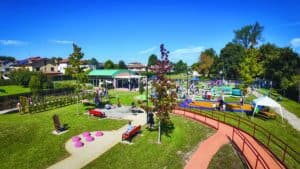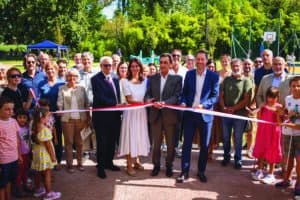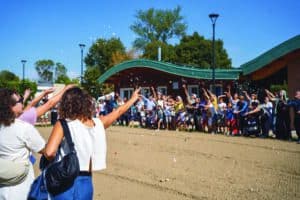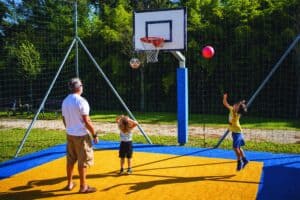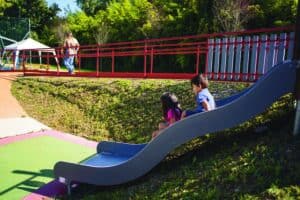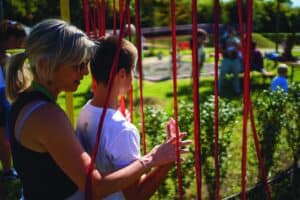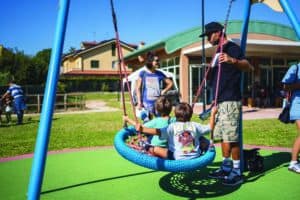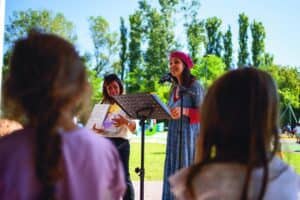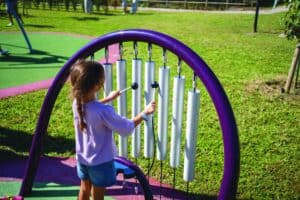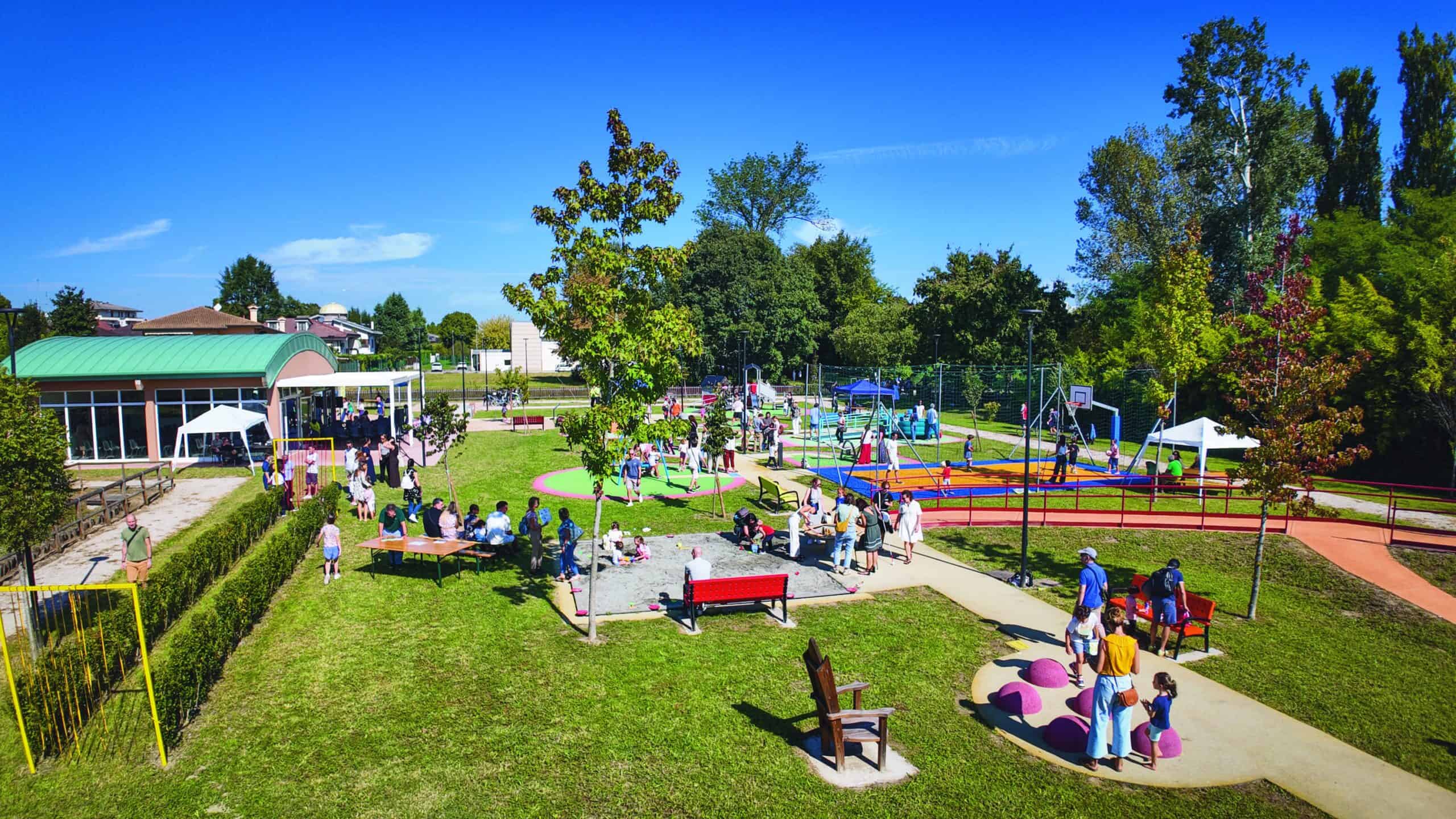The official opening on Saturday, September 20, of “Treasure Tree” was a day of celebration for children and families, exciting for everyone, especially for the people who in each of their spheres, with passion, commitment and determination, contributed to the birth and development of the original project for a new park in Padua, of all and for all. A public space surrounded by greenery, inclusive and as accessible as possible: this is what “Treasure Tree” looks like, so that it can foster more welcoming and united communities.
The ribbon-cutting ceremony was presided over by Sergio Giordani, mayor of Padua; Antonio Bressa, alderman of the City of Padua’s Green Council; Gilberto Muraro, president of the Cariparo Foundation; and Maria Eleonora Reffo, director general of the Robert Hollman Foundation.
Mayor Sergio Giordani said, “It took us nine years to realize this park-I won’t hide the fact that we are a little late, but we finally got there. I have to thank Chiara Gallani, who as alderman of the municipality’s Green started the construction of the park, but before her there was Massimo Bitonci who started the project. And that means that administrators pass, but the important thing is that the works continue.”
“Today’s is a great celebration,” were the words of Antonio Bressa , “The inauguration of the Inclusive Park ‘Treasure Tree’ represents not only one more step in the strategy of expanding the green areas of the City of Padua, but above all the birth of a place at the forefront of inclusiveness and accessibility.”
“It has not been an easy undertaking,” Bressa continued, “but thanks to the determination of the Hollman Foundation, the fulfillment of the commitments made by the municipality, and the support of the donor agencies, we can say we are proud to have created a park that is not just a play space, but a true laboratory of sociality and inclusion. This project marks an important advance in the frontier of accessibility of green areas and becomes a benchmark for all future interventions. In line with the city we are building, public green space is indeed confirmed as not only an environmental asset, but also a place for meeting, growth and community.”
“It is a great thrill to be able to welcome you here today,” remarked Maria Eleonora Reffo, general director of the Robert Hollman Foundation. ” The idea for this park was born out of the Robert Hollman Foundation’s 46 years of experience working with children with visual impairment and their families on a daily basis . We started from their spoken and unspoken stories that have always told us of their deep need for social interactions, for welcoming and inclusive places for their children. We also started from teamwork and the importance of networking, believing in each person’s potential and relaizons. Thus, after many years of work, this public place was born where everyone can feel welcome, each with their own specificities; a place that values people and relationships.”
“The Cariparo Foundation,” he began. Gilberto Muraro, president of the Cariparo Foundation-has believed from the very beginning in this project, which is on a strategic line of valuing disability, because we believe that integration can become a resource for valuing disability. Of this project, then, we are attracted by the collaboration between institutions and civil society: there are not only the Robert Hollman Foundation and the Cariparo Foundation lending a hand to the City of Padua, but many other entities and realities from the social and productive world that have been involved. And this is a sign of interest and solidarity that is magnificent to highlight!”
THE PARK
“Treasure Tree” rises in an area of 9 thousand square meters, on the outskirts of the city of Padua and within the green lung of the Lower Isonzo: the project is inspired by the daily experience of the Robert Hollman Foundation, which offers counseling and support to children with visual impairment and their families, and by the principles of the 2030 Agenda for Sustainable Development, for the promotion of the well-being of everyone at every age and with their own specificities. Furthermore, in line with the UN Convention on the Rights of the Child and Adolescent, this public place aims to promote every child’s right to play (Art. 31) without “any discrimination of children regardless of their disability” (Art. 2).
That’s why “Treasure Tree” was co-designed from its inception through the involvement of 17 entities engaged in disability and social work and more than 1,300 kindergarten and primary school pupils, so that it would be a place dreamed, thought of and made by all and for all.
Led by the City of Padua and the Robert Hollman Foundation, the co-projecting entities were Anfass Padua, Associazione Fiori Blu, Associazione Pulcino, Associazione Uniti per crescere, Centro Medico Foniatria, Coislha Social Cooperative, Federazione Nazionale delle Istituzioni Pro Ciechi di Padova, Irpea Foundation, Oic Foundation, Polis Group, Irifor Padua, Configliachi Institute, Lega del filo d’oro Padua, La Nostra Famiglia, Uildm Padua, Unione Italiana Ciechi e Ipovedenti Padua and University of Padua.
In addition to the fundamental economic investment of the City of Padua in the construction of the park, almost all of the play areas, part of the sensory area and the aggregation area were built thanks to donations from 16 for-profit and nonprofit entities and hundreds of citizens who generously joined the numerous fundraisers proposed over the years.
To them goes the sincerest thanks: Cariparo Foundation, Despar – Aspiag Group srl, Crédit Agricole Italia, Pink Run, Tigotà – Gottardo Group, Fonderie Pandolfo, Mitsubishi Electric, Viss srl, Rotary Club Padova, Oxford Padova Link, Coldiretti Donne Impresa, Coldiretti Padova, Barollo winery, Tennis Club Padova, Legambiente Padova, Irpea Foundation, Stories Beyond the Barrier, Play Association, the citizens and townsfolk of Padova and beyond.
LOTS OF FACILITATION TO FOSTER PLAY, WELL-BEING AND RELATIONSHIPS
The green area consists of. four areas that complement each other to meet different needs and to make its enjoyment a unique, memorable experience: theplay area with sixteen different play experiences where each child can find the most suitable for him and his specificities; theaggregative area which consists of a small square to encourage sociability, a 100-square-meter multi-purpose hall, a food and beverage venue; thesensory area which is still taking shape as plants grow and sound references are installed (raised vegetable gardens with herbs, orchard, labyrinth); thefitness area with four stations that are also accessible to people with motor impairments, to perform outdoor gymnastics alone or in company.
The park was built with as much environmental facilitation as possible to encourage orientation within it.
A few examples? The three tactile maps, placed at the park entrances and one referring to the play area next to the aggregation area.
Before entering the actual heart of the park, the path is marked by logges on the ground to aid orientation for people with visual impairments. The colorful paths of the play area wind along a geometry composed of broken lines to facilitate the creation of a mental map.
The access ramps and the size of the installed structures are suitable for walkers and sitters, those who are small and those who are a bit older. The spaces, moreover, are delimited by rubber material of different colors, to ensure safety and, through color, allow easier identification of the area of each play.
For more information: parkinclusivopadova.it
